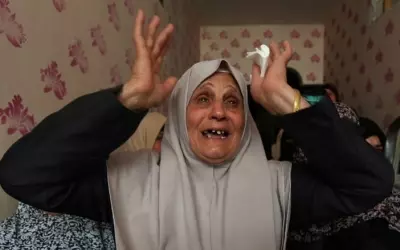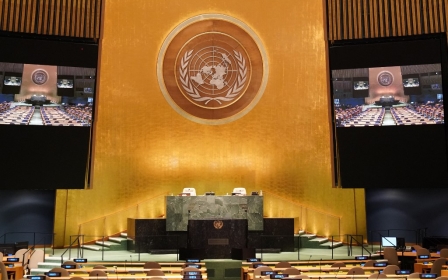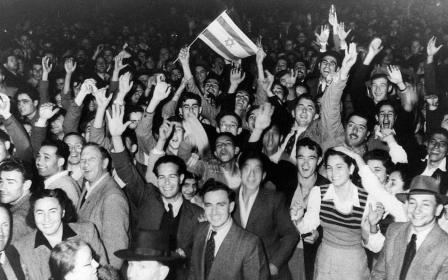Netflix told Farha's story but families like mine have many more

As Farha, a new film narrating the Nakba, fuels conversations across social media, it is also having a significant emotional impact on Palestinians.
The violence against Palestinians did not end with the establishment of Israel in 1948; it continues to this day, and every Palestinian family has their own version of the Farha story. Based on real events, the film triggered traumatic flashbacks for me of attacks carried out by the Israeli occupation in Gaza in more recent years.
This is the first time a film has told the story of the Nakba in such a concise way
As Israelis cancel Netflix subscriptions over the film, many Palestinians say it has resonated viscerally with them. This is the first time a film has told the story of the Nakba in such a concise way, allowing Palestinians to more easily understand what their ancestors went through in 1948.
The film focuses on a teenage girl named Farha who witnessed Zionist militias kill a Palestinian family. Had I lived through the Nakba, rather than being born in 1995, I cannot imagine abandoning my home like she did. When the film depicted the start of the attack on Farha’s neighbourhood, I remembered how my family used to keep all our important papers in a suitcase.
This bag was always ready during escalations, especially if the Israeli army threatened a ground invasion of the Gaza Strip, as they did in the 2008-09 war. I remember telling my parents that we didn’t want to leave, and if they wanted to kill us, they could do it at home.
Inhaling tear gas
I was 13 during the 2008 Gaza war, and I still feel my parents’ fear as they strove to keep us safe. My father made us sleep in the middle of the house, in a room with no windows, because he thought it was the safest. We all slept in the same room, because being together at home was the only way we felt safe.
The director of Farha did not need to include scenes of air strikes or live ammunition, because Palestinians know exactly how this looks. As a Palestinian journalist born and raised in Gaza, I have witnessed countless violent scenes over the years.
The tear-gas canisters used in the film brought back memories of the many I inhaled while reporting on the Great March of Return in 2018. The sound of Israeli soldiers and live ammunition brought back memories of the endless shootings during the march, particularly on the day when at least 50 Palestinians were killed. These scenes of darkness and gunfire will remain etched into my mind forever.
The attempt to shut down @FarhaFilm reflects an unfair denial of yet another basic human right to Palestinians: the ability to process trauma thru art. Rather than attack Israelis, the director of “Farha” said this impulse was at core of why it was made. https://t.co/9Er9qYlLrI
— Ahmed Eldin | أحمد شهاب الدين (@ASE) December 3, 2022
At one point in the film, a character named Farida says goodbye to her friend Farha, in a scene that reminded me of every funeral I’ve attended for Palestinians killed by Israeli forces.
Palestinians often bid their loved ones farewell, fearing never to see them again. The scene also reminded me of Palestinian nurses saying goodbye to Razan al-Najjar, a paramedic killed by Israeli forces during the Great March of Return. It’s been years since she was slain, but Farha brought back every emotion I felt at the time.
Palestinians living under occupation constantly feel unsafe. Our homes have storage rooms similar to the one Farha was locked in, amid the ever-present dread of not having access to food. These storehouses are stocked with legumes, flour, olive oil, cheese, olives and other goods that can be preserved for an extended period.
The cheese and olives that Farha ate made me think of the meals we had every night during the 51-day war in 2014. Since the cheese is so salty, we usually eat it with tomatoes or cucumbers. To decrease the salt concentration in the cheese, it is kept in water; Farha’s only source of water must have been very salty.
Living in darkness
The darkness in some scenes of the movie was also very familiar to Palestinians who live on an eight-hour cycle of power coming on and off. I don’t recall ever having a day without power outages when I was a kid.
Sometimes, especially in the winter, we took showers using water heated in pots. I remember my mom lighting candles in the bathroom while she showered us.
To sum up my childhood, I either slept or waited for the electricity to come back on. Or I cried because the power went out while I was watching my favourite show.
I grew up in a family dedicated to preserving Palestinian culture and architecture. After watching Farha, I realised that my father was inspired by old Palestinian houses when constructing our home.
When I was 10, my mother taught me Palestinian embroidery. She would make dresses for me and say: “The most elegant and beautiful thing you could ever wear is Palestinian embroidery.”
The film also emphasises the symbolism of the key, that since 1948 has been associated with the Palestinian right of return. In the film, before executing the family, Israeli forces seize a key that a woman had been hiding. Thousands of Palestinian families still have the keys to their Israeli-occupied homes.
More than 700,000 Palestinians were displaced in the Nakba, holding keys to houses that are no longer theirs. Farha’s story has now been told, but there are thousands more to come.
The views expressed in this article belong to the author and do not necessarily reflect the editorial policy of Middle East Eye.
Middle East Eye propose une couverture et une analyse indépendantes et incomparables du Moyen-Orient, de l’Afrique du Nord et d’autres régions du monde. Pour en savoir plus sur la reprise de ce contenu et les frais qui s’appliquent, veuillez remplir ce formulaire [en anglais]. Pour en savoir plus sur MEE, cliquez ici [en anglais].






